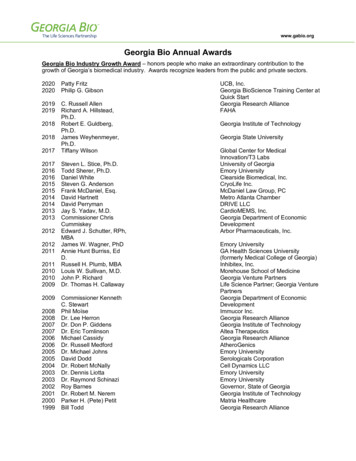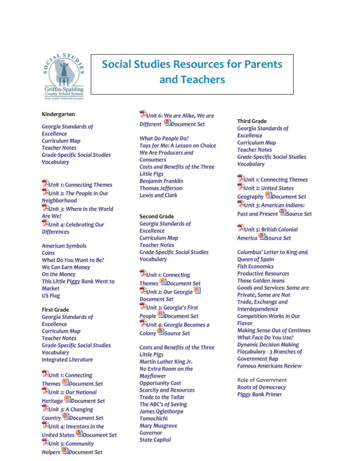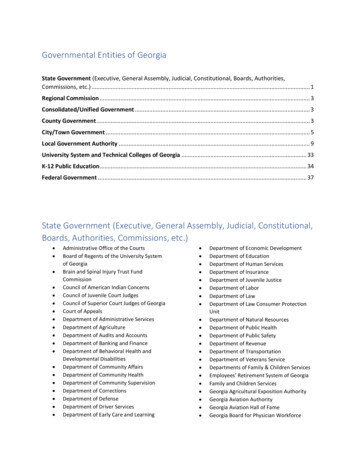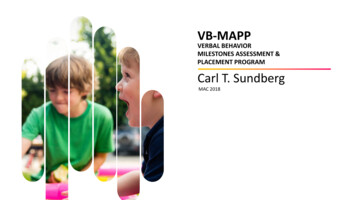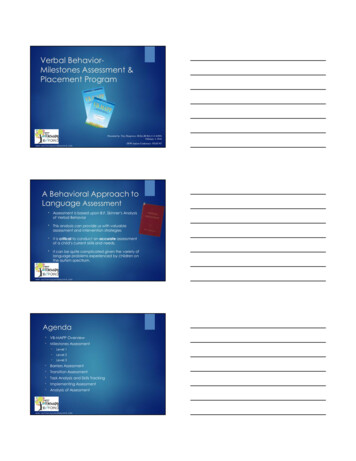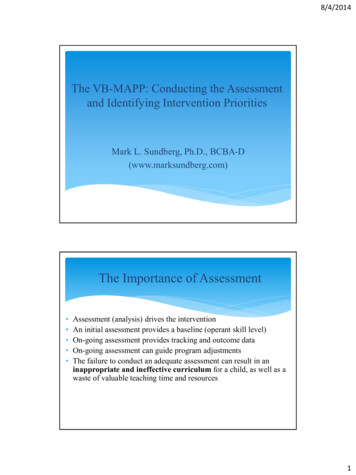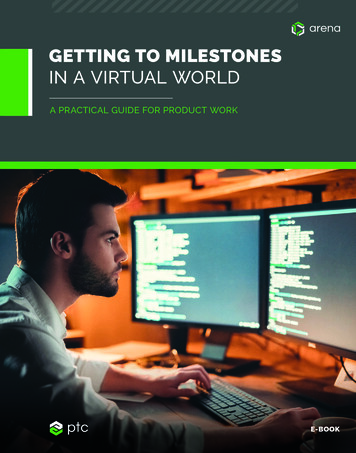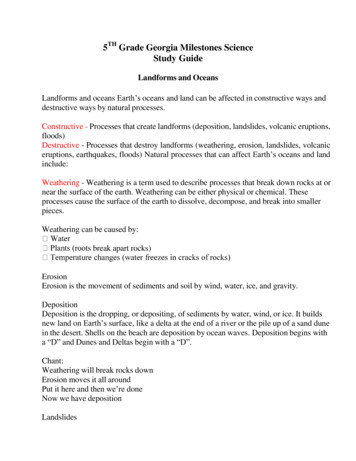
Transcription
5TH Grade Georgia Milestones ScienceStudy GuideLandforms and OceansLandforms and oceans Earth’s oceans and land can be affected in constructive ways anddestructive ways by natural processes.Constructive - Processes that create landforms (deposition, landslides, volcanic eruptions,floods)Destructive - Processes that destroy landforms (weathering, erosion, landslides, volcaniceruptions, earthquakes, floods) Natural processes that can affect Earth’s oceans and landinclude:Weathering - Weathering is a term used to describe processes that break down rocks at ornear the surface of the earth. Weathering can be either physical or chemical. Theseprocesses cause the surface of the earth to dissolve, decompose, and break into smallerpieces.Weathering can be caused by:s break apart rocks)ErosionErosion is the movement of sediments and soil by wind, water, ice, and gravity.DepositionDeposition is the dropping, or depositing, of sediments by water, wind, or ice. It buildsnew land on Earth’s surface, like a delta at the end of a river or the pile up of a sand dunein the desert. Shells on the beach are deposition by ocean waves. Deposition begins witha “D” and Dunes and Deltas begin with a “D”.Chant:Weathering will break rocks downErosion moves it all aroundPut it here and then we’re doneNow we have depositionLandslides
Landslides are mass movements of land due to gravity.Landslides can cause buildings to fall, or power and gas lines to break.Landslides even occur on the continental slope in the ocean.Volcanic eruptionsVolcanoes are mountains with openings in Earth’s crust through which magma, gases,and ash reach Earth’s surface.When the magma erupts from the volcano the top of the mountain can be changed, eitherbuilt up or exploded off. The lava and ash can destroy forests and bury fields.Volcanic eruptions can even change Earth’s weather patterns. Volcanic eruptions alsooccur under the oceans; these volcanoes that are built up are called Seamounts. If theseamount rises above the ocean surface it is called a volcanic island (for example Hawaiior Japan).EarthquakesEarthquakes are vibrations on Earth’s surface caused by sudden movement in the Earth,often along a fault, a break in Earth’s surface.Some earthquakes cause little damage and some cause a lot of damage.Large earthquakes can cause landslides.Earthquakes under the ocean can cause huge waves, called tsunamis that destroy land andcause great damage if they come ashore.FloodsFloods occur when a large amount of water covers land that is usually dry.When the flood occurs; rapid erosion can take place and move soil and sediments away.When the flood recedes; new sediment is left behind and can build up rich soil deposits.Landforms of the Ocean FloorContinental shelfThe edges of the continents slope down from the shore into the ocean.The part of the continent located under the water is known as the continental shelf.The width of the continental shelf can vary. In some places the continental shelf is fairlyshallow and in other place it becomes very deep, but it is not the deepest part of theocean.Continental slopeThe steep slope where the continental shelf drops to the bottom of the ocean floor is
called the continental slope. The depth of the ocean water increases greatly here.Mid-ocean ridgeOn the bottom of the ocean, there is a central ridge, or mountain range, that divides theocean floor into two parts called the mid-ocean ridge. Volcanic mountains not formed onthe mid-ocean ridge are called seamounts.Rift zoneIn the center of the highest part of the mid-ocean ridge is a narrow trench called a rift.Underwater volcanic activity that adds mountains to either side of the mid-ocean ridgeoccurs at the rift zone .TrenchesThere are many steep-sided canyons and deep, narrow valleys in the bottom of the ocean.Ocean trenches are the deepest part of the ocean basin and are deeper than any valleyfound on land.Ocean basinLocated on either side of the mid-ocean ridge is the ocean basin. It is made up of lowhills and flat plains. The flat area of the ocean basin is called the abyssal plain.Seamounts are generally formed on the ocean basin.beaches.deposit sand along the shore and form a beach. If the waves reach the beachat an angle, the sand is moved along the coast.location to another.when the tide goes out.on that removes sand from beaches. Barrier islandsare called barrier islands.As the waves deposit sand on the beaches, the shapes of the barrier islands change.Estuariesestuary.
the estuary.Inlets-filled spaces between the barrier islands.Large storms, for example hurricanes, can also cause massive construction or destructionof beaches, barrier islands, estuaries, and inlets because they produce high waves, stormsurges, and winds. Water can be moved by waves, currents, and tides.Wavese highest part is known as the crest and the lowestpart is known as the trough .t forms a breaker.volcanic eruptions, or landslides.Currentsdirection are called currents .of wind.rved paths.currents.latitudes.m the polar latitudes toward theequator.Tides
on Earth.ater level is at its lowest point.Human Activity can affect the land and oceans of Earth.Humans can help protect the land and oceans by preserving the natural resources theseareas provide.Examples of natural resources include: air, water, trees, rocks, minerals, soil, coal, andoil. Using resources wisely is call conservation. Ways to conserve our resources include:-up projects-nourishment projects to protect sand on beachesaway soil Pollution is anything that harms the natural environment.Human activities that can pollute the environment include:ials from industry, mining, or agriculture onto the land or into thewaterChapter 3: Physical and Chemical Changesin Matter Study GuideWhat is matter?Anything that has mass and takes up spaceMass is .The amount of matter in an object.Measured in grams, kilogramsVolume is .The amount of space an object takes up.Measured in milliliters and liters
How would you find the volumeof an irregular object, such asa rock, using only a graduatedcylinder and water? Describethe process.Read and record the volume of the water.Drop the rock into the water. Read andrecord the volume of the rock and thewater, then subtract the volume of thewater from it.Describe how particles ofmatter are arranged in aSOLID. Draw a pictureshowing this arrangement.Particles are tightly packed together. Theycan vibrate, but cannot move out ofposition.Describe how particles ofmatter are arranged in aLIQUID. Draw a pictureshowing this arrangement.Particles are further apart, and can flowpast one another.Describe how particles ofmatter are arranged in a GAS.Draw a picture showing thisarrangement.Particles are much farther apart, rarelycoming in contact with one another.What always happens during achemical reaction? Give anexample of a chemical reaction.A new substance is produced.What are physical properties?What are examples of physicalproperties?Properties that can be observed using yoursenses.Answers may varyColor, shape, size, texture, function,density, state of matter.
What are chemical properties?When are you able to observethem?Properties that describe how matterchanges into new types of matter. You areonly able to observe them during achemical change.What happens to matter in aphysical change?Matter changes physically, but nothing newis created. It is still the same type of matter.What are some examples ofphysical changes?Tearing paper, slicing carrots, waterchanging to water vapor, etc.What happens to the particlesof matter when heat is addedto it?The particles speed up and start movingfaster. Sometimes a phase change canoccur.What happens to the particlesof matter when heat is takenaway from it?The particles slow down and move moreslowly. Sometimes a phase change canoccur.Describe the phase changeduring:Melting:Boiling:Condensing:Solid to liquidLiquid to gasGas to liquidLiquid to solidFreezing:In which phase of matter areparticles moving fastest?Slowest? Why?Particles move fastest in gases. They moveslowest in solids. Gases have the mostthermal energy and solids have the least.
What is a mixture? Give someexamples of mixtures.A mixture is made up of two or more typesmatter that are combined physically,1. Party mix2. sand and water3. AirWhat is a solution? Give anexample of a solution.A type of mixture in which substances arethoroughly dissolved and do not separatewith gravity.An example is sea water.How are mixtures andsolutions alike? How are theydifferent?Mixtures and solutions are made of matterthat is physically, not chemically combined.In solutions, you cannot see the individualparticles because they are dissolved in thesubstance.What happens to the particlesof matter during a chemicalchange?In a chemical change, the particles ofmatter break apart and form new types ofmatter with different properties.Give some examples ofchemical changes.1.wood burning2. fireworks exploding3. metal rusting4. cake bakingWhat are clues, or evidence,that a chemical reaction hastaken place?Evidence that energy was used or given off,the properties of the new substance aredifferent than the original substances, andthe change cannot be easily reversed.
In a physical change, the matter changesform, but nothing new is created. In achemical change, new substances wereformed with different properties.How is a physical changedifferent from a chemicalchange?To prepare for your test, makesure to:1. Re-read chapters 4 and 5 inthe Science book1. Study through all of your notes andreread in your textbook pgs. 124-163Lessons 1-32. Have someone quiz you over the studyguide questions.Electricity and Magnetism Study GuideVOCABULARYchargeA measure of the extra positive or negativeparticles that an object hascircuitA path that is made for an electric currentconductorA material that electric current can pass througheasilyelectric cellA device that supplies energy to move chargesthrough a circuitelectric currentA flow of electric chargeselectric fieldsThe space around an object in which electricforces occurAn arrangement of wire wrapped around a core,producing a temporary magnetelectromagnet
insulatorA material that current cannot pass through easilymagnetAn object that attracts certain materials, such asiron or steelThe space all around a magnet where the force ofthe magnet can actThe end of a magnetA circuit that has more than one path along whichcurrent can travelA material that resists the flow of current butdoesn't stop itA circuit that has only one path for currentAn electric charge that stays on an objectmagnetic fieldmagnetic poleparallel circuitresistorseries circuitstatic electricityCRITICAL THINKING1. What kind of electricity is caused by friction?Static Electricity is caused by friction.2. How are charged particles in matter affected when two objectsare rubbed together?All matter is made up of tiny particles that have electric charges.Some of these particles have a positive charge. Other particles havea negative charge. Rubbing two objects together may cause some ofthe negative charges to rub off one object. The charges move to thesecond object. This gives the second object a greater negativecharge than the first object.3. How is current electricity produced?Current electricity is produced when negative charges move along apath.4. What is a circuit? What are the parts of a circuit?A circuit is the path along which negative charges move.
There are four parts to a circuit:(1) There is a source of electricity Example: A battery(2) There is a path along which charges can move. Example: A wire(3) There is a switch that opens and closes the circuit. Example: Aknife switch(4) There is some object that uses the electricity. Example: A lightbulb5. Explain the difference between a complete circuit and anincomplete circuit.When a switch is closed or turned on, the path of electricity iscomplete. The charges move. A circuit whose path is complete iscalled a complete circuit. When the switch is open, or turned off,the path is broken. The movement of charges stops. The path isincomplete. A circuit whose path is incomplete is called anincomplete circuit.6. Explain how electricity is produced in a flashlight.A dry cell battery is the source of electricity in a flashlight.7. What are the three ways to make electricity?Electricity can be made from chemical energy in dry cell batteriesand wet cell batteries, and from mechanical energy in generators.8. What would show the magnetic field of a magnet?A magnetic field may can be seen when iron filings are sprinklednear a magnet. The iron filings form a pattern of lines. These linesare called lines of force. Lines of force show where the magnetic fieldis and what it looks like.9. Explain the difference between the two poles of a magnet.The ends of a magnet are called the poles. A magnetic field isstrongest at the poles. A magnet has two poles - a north pole and asouth pole. The poles are equal in strength.
The north pole of one magnet attracts the south pole of anothermagnet. The south pole of one magnet attracts the north pole ofanother magnet. But the north pole of one magnet repels, or pushesaway, the north pole of another magnet. In the same way, the southpole of one magnet repels the south pole of a second magnet.10. How are particles in magnetized iron different from those in unmagnetized iron?Most magnets are made of iron. The particles that make up iron arelike tiny magnets. In a normal piece of iron the particles are allmixed up. They point in different directions. In a magnetized pieceof iron the particles point in the same direction.11. How is magnetism used to produce electricity?Magnetism can be used to produce electricity. This can be done bymoving a magnet through a coil of wire. Electricity is produces aslong as the magnet moves through the coil. A generator produceselectricity this way.12. What are some uses of electromagnets?Electromagnets are often used in scrap yards to lift metal and moveit. Many electromagnets are strong enough to lift heavy objects,such as cars. Electromagnets are also used in telephones.13. In what ways are electricity and magnetism alike?Electricity and magnetism both produce a force that can pull orpush things without touching them. They both have opposite states:electricity has positive and negative, and magnetism has northseeking and south-seeking. In both, opposite states attract andsame states repel.14. What will happen if you put a compass next to an electromagnetthat is switched on?
The compass needle will turn because an electromagnet produces amagnetic field. The magnetized compass needle will move to line upwith the field lines.Series and Parallel Circuits
MagnetsMicroorganisms and Cells Study GuideVocabulary Terms to KnowBacteria – Kind of microorganism shaped like rods, spirals, or balls.Organ system-Organs that work together to do a job for the body.
Cell – The basic unit of structure and function in living thingsMicroorganism- Living thing that is too small to see without a microscope.Tissue- Cells that work together to perform a specific function.Organ- Groups of tissues that work together to carry out a certain function.Mold- A fungus that is a microorganism.Protist- Microorganisms that include algae and protozoans.Concepts to Know1. Parts of an animal cell and a plant cell.Animal CellPlant Cell2. What is the difference between a plant and animal cell? One is found in plantsand the other is found in an animal. Plant cells are square shaped and the animalcell is more circular shaped. You can find a cell wall in a plant cell along withchloroplasts; neither can be found in an animal cell.3. What is connective tissue and where it can be found? Connective tissue isConnective Tissue is the tissue that supports and connects the various parts of thebody in your bones4. What microorganisms are and what they do (helpful or harmful)?Microorganisms living organisms that are too small to be seen with the naked
eye. Some types of microorganisms are bacteria, viruses, fungi, algae, andprotozoa. Some are harmful and some are helpful.5. What basic structure and function of all living things is? The basic structure ofall living things is a cell.6. Compare and contrast single celled and multi-celled organisms. Cells in singlecelled organisms carry out all their life’s functions. Cells in a multi-celled alsocarry out all the functions necessary to stay alive. In addition, cells in multicelled organisms work together with other cells to keep the organism alive.7. What would happen if a cell was without a nucleus? A cell would probablynot function without a nucleus. The nucleus directs all the cell’s activities.Without a nucleus, the cell may not be able to do everything it needs to forsurvival.8. How do your muscles affect your circulatory system? Without muscle tissue,the circulatory system would not be able to pump blood to all the parts of thebody.Plant and Animal Classification1. A flowering plant that has seeds protected by fruit is an angiosperm.(Example: Apple Tree)2. Gymnosperm is a plant that has naked seeds. (Example: Pine Tree)3. You should know that ferns reproduce with spores, not seeds. You shouldknow that pine trees reproduce with seeds in cones, not flowers.4. Vascular tissue is a tube like material that supports a plant and allows waterand nutrients to move through the plant. There are two types of vascular tissue.(xylem and phloem)5. Tissue that carries water and nutrients from the roots to every part of the plantis called xylem.6. Phloem is a tissue that carries food from a plant’s leaves to its cells.7. Invertebrates are a group of animals without backbones.8. A group of animals with backbones is vertebrates.
9. Classification is organizing things into groups based on how the things arealike. One reason scientists classify living organisms is because it makes findingand sharing information easier.10. The seven parts of the scientific classification system from largest to smallest.(Kingdom, Phylum, Class, Order, Family, Genus, Species)11. Species is the smallest group for classifying living things12. Kingdom is the largest group for classifying living things.13. There are more invertebrates than vertebrates.14. The main difference between members of the plant kingdom and members ofthe animal kingdom is that plants make their own food and animals eat otherliving things.15. Vascular plants use tubes to get water and nutrients where they need to goand they usually grow much taller than non-vascular plants. An example of avascular plant is a tree .16. A non-vascular plant does not have tubes. Water travels from cell to cell in anon-vascular plant. An example of a non-vascular plant is moss.17. Mammals and birds are warm-blooded18. Mammals are a group of vertebrates that give birth to live babies.19. Fish, Amphibians and Reptiles are cold-blooded.20. Amphibians live on land and in water at various times during their life.21. Cold blooded – animals whose body temperature changes with theirsurroundings22. Warm Blooded – animals whose body temperature stays the same no matterhot the temperature changes around them.23. Classify – to group things using a set of rules.24. Vascular – plants that have tubes25. Non-vascular – plants that do not have tubes26. Pollen – a special dust that helps plants reproduce
27. Spore – a tiny cell that grows into a new plant**You should be able to label the diagram that we placed in your sciencenotebook that starts with animals then breaks down into vertebrates andinvertebrates, warm-blooded, cold-blooded and finally into mammals, birds, fish,amphibians and reptiles. (This diagram shows you how we group animals.)**(You should be able to label the diagram that we placed in your sciencenotebook that starts with plants, then breaks down into vascular and nonvascular, seeds, no seeds, flowers, no flowers. (This diagram shows you how wegroup plants)**You should be familiar with the characteristics of the five types of vertebrateswe discussed: Mammals, Birds, Fish, Reptiles and Amphibians. You drew fivecharts with the characteristics of these animals and placed them in your binder.If I give you an example of an animal, based on its characteristics, you should beable to tell me which of the five groups of vertebrates that it belongs in.Plant and Animal KingdomsThe Five KingdomsAnimal, Plant, Bacteria, Fungi, Protists, and Plant KingdomThe Animal Kingdom is divided into:
Vertebrates and InvertebratesVertebratesThe five most well known classes of vertebrates are mammals,birds, fish, reptiles, amphibians. They are all part of the phylumchordate.MammalsPeople are mammals. So are dogs, cats, horses, duckbillplatypuses, kangaroos, dolphins and whales. If an animal drinksmilk when it is a baby and has hair on its body, it belongs to themammal class. Dog , Coyote , Polar Bear , Elephant , Giraffe ,Camel , Dolphin , Vampire Bats , Horse , FoxBirds
Birds are animals that have feathers and thatare born out of hard-shelled eggs. Some peoplethink that what makes an animal a bird is itswings. Bats have wings. Flies have wings. Batsand flies are not birds. The truth is that it is thefeathers who makes an animal a bird and notwings. All birds have feathers and birds are theonly animals that do. The feathers on a bird'swings and tail overlap. Because they overlap, thefeathers catch and hold the air. This helps thebird to fly, steer itself and land. Crow , Peafowl ,Birds , Duck , Owl , Pigeon , Flamingo ,Woodpecker , Ostrich , Sparrow , ChickenFishFish are vertebrates that live in water and have gills, scales andfins on their body. There are a lot of different fish and many ofthem look very odd indeed. There are blind fish, fish with noseslike elphants, fish that shoot down passing bugs with a stream ofwater and even fish that crawl onto land and hop about! FishesReptilesReptiles are a class of animal with scaly skin. They are coldblooded and are born on land. Snakes, lizards, crocodiles,alligators and turtles all belong to the reptile class. Reptiles ,Crocodile , Chameleon , Tortoise , TurtleAmphibiansAmphibians are born in the water. When they are born, theybreath with gills like a fish. But when they grow up, they developlungs and can live on land. FrogInvertebrates
There are also a lot of animals withoutbackbones. These are called invertebrates andare part of the phylum arthropoda (arthropods).Two of the most commonly known classes inthis phylum are arachnids (spiders) and insects.ArthropodsArthropods is aincludes ta.huge phylum of animals -- itanimal classes: lopoda,Chilopoda,Diplopoda,andAny animals that have more than four, jointedlegs are arthropods. Insects, spiders andcrustaceans all belong to this class of animals.Insects, Spider, Grasshoppers, Praying Mantis,Dragonfly, Butterfly, BeesGrowth and InheritanceHumans and other animals are a mix of characteristics from their parentsand behaviors they learned on their own. A physical characteristic thatis passed from a parent to their baby (offspring) is an inherited trait.Inherited Traitso Eye coloro Skin coloro Hair coloro Curly or straight hairo Dimpleso Freckleso Height
Are your ear lobes attached to the side of your head, or do theyhang free? The shape of your ear lobe is an inherited trait.Inherited BehaviorsooooA behavior is a way of acting. Behaviors can be inherited too.Inherited behaviors are called instincts.Many animals are born with instincts that help them survive.Can you think of any animal instincts?Inherited Behavior examples o When the weather turns chilly in the fall, animals prepare for thewinter by instinct.o Some animals head for warmer climates during the winter. Otheranimals find a safe spot and curl up for a long sleep.o No one taught these animals how to survive winters. They knowwhat to do by instinct.o Birds protect their eggs and babies by instinct.o Frogs are not born with this instinct. They leave their eggs tohatch-or die- on their own.o Can you think of any additional inherited behaviors (instincts).
Learned Behaviorso Are you better at using the computer than some of the adults inyour family? If so, you learned how to do this. You did not inheritthis behavior from your parents.o We learn many behaviors that help us every day. These behaviorsinclude how to make a sandwich, wakeboard, and be polite toothers.Science Process SkillsObservingWe observe when we use one or more of our senses to find outabout objects, events, or living things. An observation is a factlearned directly though the senses.- use more than your eyes– add detailsteran event)
There are two types of observations:1) Qualitative Observations are those that describe whatsomething looks, smells, tastes, sounds, or feels like.Example: The flower is red and smells sweet.2) Quantitative Observations are those that provide some type ofmeasurement or comparison.Examples: The rock has a mass of 5 grams. The boy has two arms. Thereare fewer students in the science class than the math class.CommunicatingWe communicate when we send or receive information. Be clear anduse details when you communicate.ClassifyingWe classify when we use observations to group objects or eventsaccording to how they are similar or different.into smaller groupssure to write down how you classified the objects or events so thatyou can tell someone else how you did itMeasuringWe measure when we compare something to standard or nonstandardunits. Length, mass, and time are the basic units of measurements.In science, always use metric unitsmeasureInferringWe infer when we use what we already know to draw conclusions andfigure out reasons for events that we don’t witness.
Inference – an explanation of an observation based on prior knowledge(experience or facts).Example: The holes in the leaf were made by an insect.Predicting/HypothesizingWe predict (make hypotheses) when we make a forecast about what willhappen in the future. The prediction is based on what you already knowand data that you have collected.e observations and measurements (collect data)ew prediction if you are wrong(Prediction) – tell what will happen next.Example: The Clemson Tigers will win their next football game. 3Science InvestigationA fair test is one in which only one variable is changed or tested. Amanipulated (independent) variable is the one factor that ischanged or tested by the student doing the investigation. Always putit on the x-axis. This is what is changed on purpose by theinvestigator.Think: ―I‖ in independent variable is what ―I‖ change.A responding (dependent) variable is the result of the changing of themanipulated variable. Always put it on the y-axis. Think: ―D‖ independent variable ―depends‖ on what ―I‖ change.Controlled variables stay the same or unchanged during theinvestigation.Steps to an Investigation1.) Question – Ask a question that can be tested. 2.)Research - the topic3.) Prediction – What do you predict will happen?4.) Design Your Experiment – Materials and Procedure 5.)Record and Organize Data – graphs, table, charts.6.) Explain Results– What happened? Compare the results to yourprediction.Example of an InvestigationSam sets up an investigation to find out how sunlight affects plantgrowth. He gives 2 plants the same amount of water each day, but he
places one plant in the sunlight, and the other plant in the shade. Theplant in the sunshine grows 5 cm taller than the plant in the shadeduring the 2 weeks of the investigation.The Independent Variable is the location of the plants. TheDependent Variable is the height of the plants.The Controlled Variables include the type of plants and the amount ofwater. 4 How can tools and instruments (including a timing device and a10x magnifier) be used safely and accurately when conducting ascientific investigation?Science Tools Char tName of toolEyedropperWhen usedUnits measuredMove smallamounts of liquidDrops or mlMagnifierRulerMake objects look largercm and mmMeasures length andwidthPan BalanceCompare mass ofobjectsGramsThermometerMeasure temperaturedegrees CelsiusBeakerMeasure volume ofliquidsL and mlForceps /TweezersPick up /hold small objects
the Science book 1. Study through all of your notes and reread in your textbook pgs. 124-163 Lessons 1-3 2. Have someone quiz you over the study guide questions. Electricity and Magnetism Study Guide VOCABULARY charge A measure of the extra positive or negative particles that an objec



